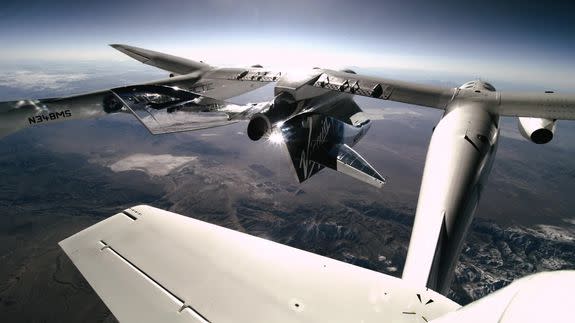Jaw-dropping video shows Virgin Galactic pilots blasting into space


The spaceship Unity left Earth Friday morning and then successfully glided back down to California's Mojave desert.
Virgin Galactic pilots Dave Mackay and Mike Masucci flew the aerospace company's fifth-supersonic powered test flight — with a working passenger aboard, chief astronaut instructor Beth Moses. After taking off from a runway attached to the WhiteKnightTwo "mothership," Unity then detached at some 45,000 feet before its rocket motor ignited and the craft blasted into space.
There, at 55.85 miles above Earth, the crew viewed the black realms of space and experienced weightlessness.
The spacecraft carried more weight than it ever has before, near the loads expected if it had a full load of passengers on board, the company said.
Following the jaunt to space, VSS Unity reentered Earth's atmosphere and safely glided down to the Virgin Galactic space port in California's windswept Mojave desert.
In early February, two Virgin Galactic pilots were awarded astronauts wings by the U.S. Department of Transportation, after they guided the VSS Unity to just over 51 miles above Earth in December. It was the first time the company reached space.
The U.S. considers 50 miles above the ocean to be the boundary between Earth and space, though many scientific agencies and organizations use the Kármán Line — 62 miles above sea level — to define this imaginary border.
The boundary, then, is fuzzy. But Virgin Galactic's footage certainly illustrates an outer space experience. The company's CEO, billionaire Richard Branson, said he plans to fly to space aboard Unity by this summer.
If the company's continued test flights all prove successful, customers will pay $250,000 for a trip to space, which from takeoff to landing will last about 90 minutes. Passengers will experience a few minutes of weightless before the spacecraft begins its descent.
Although space tourism is still in its developing stages, Virgin Galactic has formidable competition. Blue Origin, owned by billionaire Jeff Bezos, plans to begin test flights with people aboard its New Shepard spacecraft later this year, Bezos told SpaceNews. Bezos also said New Shepard will fly above the Kármán Line, just as it already has without humans aboard.
There's another big difference between the two space tourism companies. Blue Origin customers will blast off into space on a rocket, whereas Virgin Galactic passengers will take off and land on a California runway.
